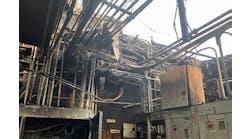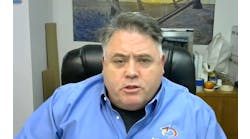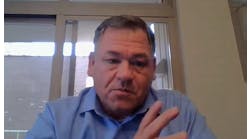Walk the modern DCS path with PlantPAx 5.0
“Aging systems increase the risk of downtime and lost production, so we're looking for the best ways to work with users to modernize their systems." Rockwell Automation’s Chris King explained the range of tools and services available to smoothly bring end users’ intellectual property forward to a modern, flexible DCS platform.
There are more than a few old distributed control systems (DCS) out there, with dedicated hardware and inflexible software, which make them hard to adjust, reprogram or upgrade as the needs of their processes have changed. Many users yearn for the flexibility that will improve their optimization and performance, but given former constraints, the way forward can often be hard to imagine let alone traverse.
To help potential users modernize their aging systems, Chris King, PlantPAx migration business development manager at Rockwell Automation, reported there are many tools, tips and strategies to convert from legacy DCSs to PlantPAx 5.0.
"The typically accepted number is there's $65 billion worth of installed DCSs that are near end of life, including many that are 25 years old," said King. "Also, many of the experts that worked with these systems have retired, and are brought back as contract labor, which increases risk. These challenges are consistent. Aging systems increase the risk of downtime and lost production, so we're looking for the best ways to work with users to modernize their systems."
King presented "Modernization and migrations from legacy DCS platforms to Plant PAx 5.0” this week in the Process Solutions User Group track with the Automation Fair At Home event, presented by Rockwell Automation.
"The main question for many users is whether their DCS is obsolete. Many users say they're keeping running with good maintenance practices, so it's not obsolete. However, once parts start failing, many start failing around the same time, and it may be impossible to replace so many at the same time in a hot-cutover fashion, especially if there's been a loss of competent, in-house expertise."
Barriers and drivers
King reported that typical barriers to modernization include still-functioning legacy systems, financial justification challenges, perceived risks of conversion, possible downtime and lost production, and technical complications requiring outside assistance. "We ask users who say their systems are still working about the hidden costs of keeping them working, such as unplanned downtime, and make sure we can explain the benefits of making a change. Users often associate change with risk, but we believe a little 'well-planned downtime' is worth it if it can eliminate future risks and larger costs."
Conversely, King reported factors that inspire users to finally seek modernization include system faults and failures, resources lost due to retirements, inadequate documentation, added support costs, system limitations, and the chance to employ new standards and technologies. Similarly, possible benefits and justifications for DCS modernization include increased production with better automation, improved quality or efficiency, better regulatory compliance, reduced labor costs, fewer operating risks, reduced legacy support costs, and the chance to improve production agility.
Modernization defined and pursued
King explained that DCS modernization is a wide-ranging process to convert obsolete legacy controls to a modern platform, but it's also an opportunity to improve plant operation. This means modernization requires a good design, and must be part of a process application's overall lifecycle that must be sustained after initial construction.
"Modernization is a process, not a one-time, one-shot project," said King. "Modernization improves both the legacy system and the process. Replacing an old DCS with the same controls doesn't provide any return on investment. However, modernization projects are complicated, and people simply don't know what they don't know, so it’s important to get help from an organization like Rockwell Automation that does modernizations every day."
Once a user decides to pursue modernization, King stated that a typical project begins with a front-end loading (FEL) process that defines its scope and planned steps, including cost estimates and scheduling. The three typical FEL steps are:
-
Aligning automation opportunities with business needs and goals;
-
Determining preferred program options and obtaining capital funding; and
-
Finalizing scope, cost and schedule for the automation project.
FEL goals usually include financial justifications, reliable preliminary engineering, execution planning and the evaluation of risks associated with all of the above, said King. "We also believe early-engagement FELs are important because costs are lower and the ability to change outcomes is greater. We want to make sure projects aren't undercut by skimping on planning and budgeting."
Once justification and planning are done, King reported the two main conversion strategies are rip-and-replace or phased. "Rip-and-replace is generally riskier, more costly upfront, and likely requires an extended shutdown, so the preferred approach is usually phased because it doesn't require shutdown and is less risky, even though it may take longer and cost more later," he said. "We believe the five best practices for reducing the risks and easing concerns about modernization are: early planning, engaging experts, establishing standards, execution discipline and expected innovation—so the old system won't simply be replicated."
Phased migration tools
King reported that Rockwell Automation offers many solutions for assisting with and performing phased migrations. These include conversion services, database conversion tools, OPC server software, custom cabling, engineered interfaces and I/O scanner modules.
King added that Rockwell Automation can help users convert from many well-known DCS systems, and its Service and Solutions Business (SSB) has also developed tool-assisted migration services. These include legacy-system exports, crawler and application code managers for automated and manual conversion, and reviews of legacy logic, graphics and configurations to normalize platforms. Extracted data is moved into Studio 500 software, where it can be converted into a PlantPAx application.
"Porting over configurations and other data is useful because it means users don't have to rewrite or remap what they've done before," added King. "This is just another of the many ways that PlantPAx creates lifecycle advantages for users."
The editors of Control, Control Design and Smart Industry are providing coverage of Automation Fair At Home, bringing you breaking news, innovations and insights from the virtual event. Once Automation Fair At Home is over, the editors will put together an event report featuring the top news. Pre-order your copy today.







